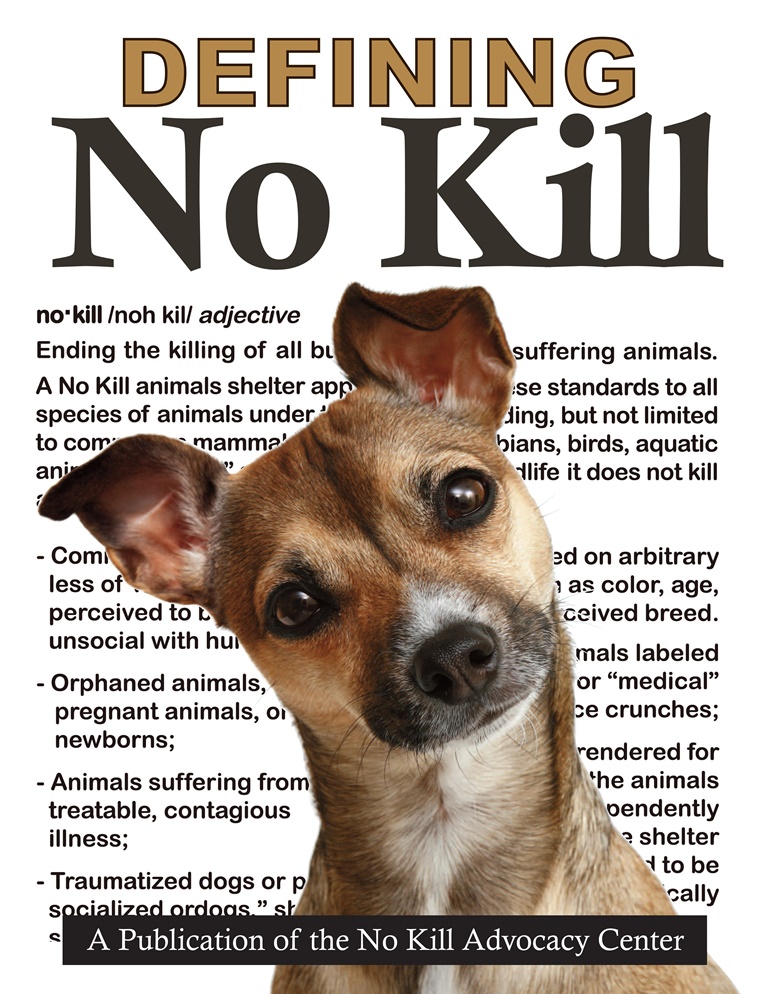From the No Kill Advocacy Center:

An end to the killing of all non-irremediably suffering animals.
“Irremediable physical suffering” means an animal who has a poor or grave prognosis for being able to live without severe, unremitting pain even with prompt, necessary, and comprehensive veterinary care.
In our ongoing effort to bring rigor, accountability and transparency to American shelters, we are proud to release “Defining No Kill,” a guide to prevent existing misuse and abuse of the term, and to ensure that even those shelters which have achieved success continue to innovate and modernize sheltering operations until all animals entering those shelters receive the loving care that is their birthright.
At the No Kill Advocacy Center, we come by the definition and guiding principles within this guide through several means: evidence, analysis, an awareness of how far the sheltering industry has progressed over the last decade, and an unequivocal commitment to the highest ideals of the animal protection movement. Nonetheless, we recognize that some of what we advocate involves discussions that many do not want to have. They will argue that the definition and guiding principles are premature and would be more politically convenient to embrace at a later date, when more or most communities are saving better than 95%. In other words, they will claim that we are setting the bar too high.
We disagree. Much of what our organization has advocated over the past decade was also greeted with admonition and decried as impossible but has since been adopted by hundreds of shelters and organizations nationwide, including some of the largest in the nation. There is no reason to assume that further innovation will not likewise receive the same eventual acceptance. Second, and more importantly, it is our duty to do so. With animal shelters throughout the nation claiming to be “No Kill” while simultaneously killing animals who are not irremediably suffering, ignoring the plight of these animals by allowing such shelters to claim success short of the actual goal line means animals not only needlessly lose their lives, but that we risk embodying the very things the No Kill movement was founded to combat: the stagnation and complacency with killing that characterized generations of shelter leaders following the industry’s founding.
The animals still being killed matter just as much as those who no longer face death, and for many of them, such as behaviorally challenged dogs, our duty is compounded by the fact that we—as humans—are often responsible for their condition through our neglect, abuse, and undersocialization. Relieving us of that burden by killing such animals does not result in redress for them.
This view does not mean we deny that some communities currently face infrastructure, legal, and other impediments to saving all these animals at this time, but rather that we do not allow such current limitations to hinder our vision, to stop us from setting aspirational goals and continually striving to improve the care of the animals served by working to overcome those obstacles. Indeed, the underpinning of the No Kill philosophy is that it goes beyond what is commonly assumed to be a practical necessity by focusing on what is morally right. It is, first and foremost, a movement of beliefs, of ethics, of what our vision of compassion is now and for the future. Its success is a result of a philosophy prompting us to do better; to embrace more progressive, life-affirming methods of sheltering that address the needs of animals still falling through the safety net of care. Failing to admit to the existence of such gaps means the impetus to eliminate them simply disappears.
Before many of us within the No Kill movement felt comfortable with the answer to questions of whether or not “feral” cats suffered on the street and whether or not No Kill was possible, we had already rejected mass killing. We had rejected practical explanations based on a “too many animals, not enough homes” calculus, or that a death was preferable to indeterminate future suffering. Even though early in the No Kill movement’s history, though the practical alternative of the No Kill Equation was yet unknown, the movement still recognized that whatever practical explanations there were to “justify” it, the killing was still wrong and had to be rejected. Moreover, calculations which elevate expediency over what is right are generally inaccurate and historically, have been used to excuse atrocities. Ethics will always trump the practical and the two are seldom so inexorably linked that an untoward action must follow some fixed practical imperative.
Every action taken by animal advocates must be subservient to preserving life, a principle that not only puts our movement in line with the successful rights-based movements that have come before ours, but is a philosophy that fosters the motivation necessary for us to figure out how we can bring our aspirations into reality. That is the job and duty of the animal protection movement, not—as it has historically done—to justify or enable the killing of animals with tired maxims that are not subjected to rigorous analysis.
A better and ethically consistent future in animal sheltering inevitably awaits us if the No Kill movement can continue to do what it has always done until every last animal entering our nation’s shelters—whatever the species, whatever the challenge—no longer faces killing: overcome the flawed but mutable traditions we have inherited from prior generations. The sooner we recognize the need for change and further innovation, the sooner we will find the motivation and tools to bring that brighter future into reality.
Download the free guide by clicking here.
Defining No Kill is just one of 16 guides to shelter reform that make up our No Kill Advocate’s Toolkit. Download all of them by clicking here.
————-
Have a comment? Join the discussion by clicking here.